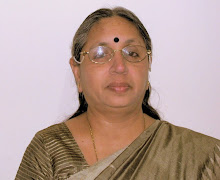Fifteen year old Amini was returning from Gokhale Memorial Govt Girls’school when her neighbour Kala’s mother gestured her urgently to come to their door. Amini quickly ran up to their door
‘. Shhh—not a word to anyone in your house or in the neighbourhood here ,’ Lalita mami cautioned her ,’Quietly go and bring to me the beautiful cross stitch tablecloth and the smart canebasket you made last week.’
To the confused looking Amini, Lalita mami explained briefly-“They are coming for Kala’s bride seeing ceremony. We have to show them some skills of Kala.She is not talented like you. I will return your tablecloth tomorrow. Now hurry and tell no one. Eh…remember “.It sounded more like a plea than like an order.
As Amini shook her head side- to- side rapidly in affirmative and prepared to leave , she caught sight of her Kala Akka smiling weakly from the inner room .
A month later, Kala Akka was married and gone, But Amini could never get to know how far her tablecloth and cane basket had helped in finalizing the marriage. But disquiet grew within her. Wasn’t it cheating? Again, why was a cross stitch tablecloth necessary to get husband? Was it not enough for Kala to be accepted for being a kind and gentle person?
Yet, how could she discuss it with anyone? She had not told even her mother whose crude and loud manner had often embarrassed her.. Her mother was sure to broadcast it all neighborhood and that won’t have been fair on Kala.
As time passed, she was to learn more. She saw a cousin rigorously practising singing ‘Samaja vara gamana’ for days together to get it perfect for the bride approval ceremony. So, decided Amini, this is why my parents have insisted on my learning Carnatic music, despite the distant travel and at the cost my studies, so that one day, I may be approved by the groom. But, what does a groom have to do to get the approval of the bride’s family?
The Question rose in the mind but no answers came.----neither from the mind, nor from the society.
One night, she put this question to her grand Athai, who had come for a short holiday. Athai let out a loud guffaw.’ Hoho, hihi, Boys have to do nothing!. It is enough for them to have a male organ.! Not even necessary for them to earn!!. Do you know that I was asked by my prospective groom’s mother to thread a needle as proof of my good vision? Further, I was asked to stretch out both my hands to show they were equal because my approval photo showing one hand resting on a flower stand aroused doubt in my cynical mother in law.!!
Amini was shell shocked. But Why????? How is it fair? Angry and confused, a lot of stormy questions rose and fell like waves in the mind. How is the matrimony market any different from the cattle market? Amini began to dread her turn.Whenever she saw a cat, she imagined herself to be a mouse in its paws!!How dreadful, this cat and mouse game. And we call it ‘approval’ ceremony??
The time arrived sooner than expected. Everything happened quickly unknown to her. Arriving home from Ashutosh college one evening, she found delicacies being prepared .Before she could protest, she was quickly done up and ushered into the presence of prospective parents.in law. But the groom was absent.” We are
Where is
‘He is in US and like an obedient son, has left the decision to us to choose his bride.’
‘
But—how ??my parents too must see him, isn’t it ?‘– asked Amini logically.
Though taken aback a little,the gentleman smiled genially and said, ‘We have come all the way from Chennai to see you. Similarly, your parents can go and see him in
. Saying this, the man took out a photo from his pocket which showed a group of boys. ‘
Amini sizzled inside. First, he is in a group photo and then to top it, in dark glasses! Whew! How can one assess?
She could see her parents signaling to her to be silent and behave.
’”I hear you are studying English literature,….GK continued,’ …..Name some plays of Shakespeare”
So,the interview had begun.!!
Amini felt she was drowning in a wave of humiliation.A long pause followed. Her mother nudged her subtly.Her father looked anxiously at her. Amini looked blank. GK smiled complacently like a predator who has trapped his prey.Amini did not answer.
After awhile, the silence seemed oppressing and unable to bear it, GK repeated the question.
‘Who is Shakespeare?-I have never heard of him- Amini shot out with a tinge of defiance, much to everyone’s shock.
‘And also please know that I donot sing, nor cook, nor stitch’ -She quickly added, pouring out all her suppressed collective resentment of years.
Her mortified mother pinched her to be silent. But the words had escaped beyond retrieval. Her father was crestfallen. GK and his wife gazed at the floor.
It seemed like eternity before GK and wife walked out in a huff. The food and drinks remained untouched.
That night, no one spoke in Amini’s house. But this stillness was deceptive, like the calm before the storm. Somewhere, in a nondescript lane of
-







